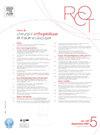Le remplacement prothétique bilatéral de hanche en une session opératoire en France
Q4 Medicine
Revue de Chirurgie Orthopedique et Traumatologique
Pub Date : 2025-01-07
DOI:10.1016/j.rcot.2024.11.004
引用次数: 0
Abstract
En cas de coxarthrose bilatérale invalidante de hanche, il est possible de réaliser un remplacement prothétique bilatéral de hanche en une ou deux sessions opératoires. La première publication sur le remplacement prothétique bilatéral de hanche en une session opératoire est due à John Charnley qui, en 1971, précisait déjà les avantages de cette stratégie : une seule anesthésie, un seul séjour hospitalier, une seule rééducation. En France, il a fallu attendre le 21e siècle pour qu’une première publication soit suivie d’une table ronde organisée en 2011 par la Société française de chirurgie orthopédique et traumatologique (Sofcot). Cet article, issu des travaux d’une seconde table ronde de la Sofcot, organisée en 2023, a pour objectif principal d’aider les chirurgiens à définir la stratégie qu’ils choisiront d’adopter devant un patient ayant besoin d’une prothèse de hanche bilatérale. Ainsi, les données du système national de santé sur 10 ans, de 2013 à 2022, montrent que l’incidence du remplacement prothétique bilatéral de hanche en une session opératoire en France est faible, inférieur à 0,4 %. Pour autant, le remplacement prothétique bilatéral de hanche en une session opératoire n’augmente pas la morbidité précoce, à condition d’une évaluation précise du risque anesthésique et d’une gestion périopératoire efficiente. Par ailleurs, cette stratégie diminuerait le risque de complications tardives. De plus, l’utilisation d’une voie d’abord antérieure ou postérieure est possible selon les préférences du chirurgien, et la reprise des activités est identique à une stratégie séquentielle. Enfin, la clef du succès est liée à la sélection des patients, ASA 1 ou 2 et âgés de moins de 80 ans. Ces éléments justifient la création d’un GHS et d’un code CCAM « PTH bilatérale » dédiés et limités aux patients sélectionnés, qui pourraient ainsi bénéficier plus systématiquement de cette stratégie, avec une économie significative pour le système de santé français.
Niveau de preuve
V ; avis d’expert.
In cases of disabling bilateral hip coxarthrosis, bilateral prosthetic hip replacement can be performed in one or two operative sessions. The first publication on bilateral prosthetic hip replacement in a single operative session was by John Charnley, who, back in 1971, outlined the advantages of this strategy: a single anaesthetic, a single hospital stay, a single rehabilitation. In France, we had to wait until the 21st century for the first publication to be followed by a round table organized in 2011 by the Société française de chirurgie orthopédique et traumatologique (SOFCOT). This article, based on the work of a second SOFCOT round table, organized in 2023, is primarily intended to help surgeons define the strategy they will choose to adopt when faced with a patient requiring bilateral hip replacement. Data from the national healthcare system over a 10-year period, from 2013 to 2022, show that the incidence of bilateral prosthetic hip replacement in a single surgical session in France is low, at less than 0.4%. However, bilateral prosthetic hip replacement in a single operative session does not increase early morbidity, provided the anesthetic risk is accurately assessed and the perioperative management is efficient. This strategy also reduces the risk of late complications. In addition, an anterior or posterior approach is possible, depending on the surgeon's preference, and return to activity is identical to a sequential strategy. Finally, the key to success lies in the selection of patients who are ASA 1 or 2 and under 80 years of age. These factors justify the creation of a dedicated GHS and CCAM code for “bilateral THR”, limited to selected patients, who could then benefit more systematically from this strategy, with significant savings for the French healthcare system.
Level of evidence
V; expert opinion.
法国髋关节双侧置换手术
对于致残性双侧髋关节挛缩症,双侧人工髋关节置换术可在一次或两次手术中完成。约翰-查恩利(John Charnley)于 1971 年发表了第一篇关于一次手术完成双侧人工髋关节置换术的文章,概述了这一策略的优势:一次麻醉、一次住院和一次康复计划。在法国,直到二十一世纪,法国骨科和创伤外科学会(Sofcot)才在2011年组织了一次圆桌会议,首次发表了这篇文章。本文是在2023年组织的第二次Sofcot圆桌会议的基础上撰写的,主要目的是帮助外科医生在面对需要进行双侧髋关节置换术的患者时,确定他们将选择采取的策略。从2013年到2022年的10年间,国家卫生系统的数据显示,法国在一次手术中进行双侧人工髋关节置换的发生率很低,不到0.4%。然而,如果麻醉风险评估准确,围手术期管理有效,单次手术进行双侧人工髋关节置换并不会增加早期发病率。此外,这种策略还能降低后期并发症的风险。此外,还可以根据外科医生的偏好采用前路或后路手术,而且恢复活动的时间与顺序手术策略相同。最后,成功的关键在于选择 ASA 1 级或 2 级且年龄在 80 岁以下的患者。证据等级V;专家意见。对于双侧髋关节关节炎致残的病例,双侧人工髋关节置换术可在一次或两次手术中完成。约翰-查恩利(John Charnley)于1971年发表了第一篇关于一次手术完成双侧人工髋关节置换术的文章,概述了这一策略的优势:一次麻醉、一次住院、一次康复。在法国,我们不得不等到21世纪才有了第一篇文章,随后是法国外科整形与创伤学会(SOFCOT)于2011年组织的一次圆桌会议。本文以2023年组织的第二次SOFCOT圆桌会议的工作为基础,主要旨在帮助外科医生在面对需要进行双侧髋关节置换术的患者时,确定他们将选择采取的策略。从2013年到2022年的10年间,全国医疗系统的数据显示,法国在单次手术中进行双侧人工髋关节置换的发生率很低,不到0.4%。不过,如果麻醉风险评估准确,围手术期管理有效,单次手术中进行双侧人工髋关节置换并不会增加早期发病率。这种策略还能降低后期并发症的风险。此外,根据外科医生的偏好,也可以采用前路或后路手术,恢复活动与顺序手术策略相同。最后,成功的关键在于选择 ASA 1 级或 2 级且年龄在 80 岁以下的患者。这些因素证明,有必要为 "双侧THR "制定专门的GHS和CCAM代码,仅限于选定的患者,这样他们就能更系统地从这一策略中获益,为法国医疗系统节省大量开支。
本文章由计算机程序翻译,如有差异,请以英文原文为准。
求助全文
约1分钟内获得全文
求助全文
来源期刊

Revue de Chirurgie Orthopedique et Traumatologique
Medicine-Surgery
CiteScore
0.10
自引率
0.00%
发文量
301
期刊介绍:
A 118 ans, la Revue de Chirurgie orthopédique franchit, en 2009, une étape décisive dans son développement afin de renforcer la diffusion et la notoriété des publications francophones auprès des praticiens et chercheurs non-francophones. Les auteurs ayant leurs racines dans la francophonie trouveront ainsi une chance supplémentaire de voir reconnus les qualités et le intérêt de leurs recherches par le plus grand nombre.
 求助内容:
求助内容: 应助结果提醒方式:
应助结果提醒方式:


